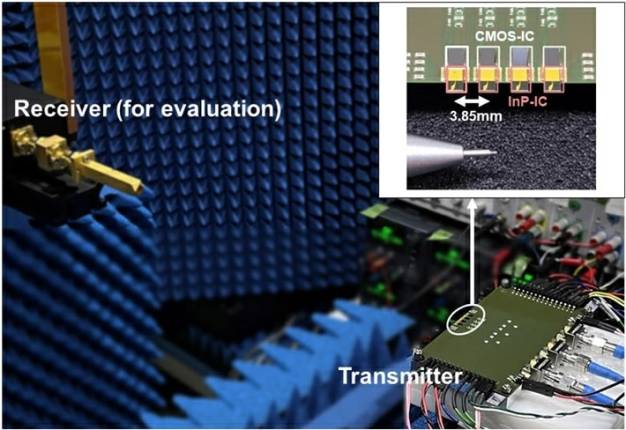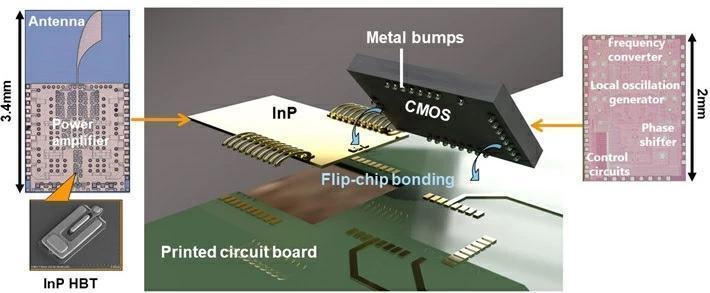A new phased-array transmitter module for 6G wireless communication has been developed by NTT Corporation (Headquarters: Chiyoda-ku, Tokyo; President & CEO: Akira Shimada; “NTT”) and Professor Kenichi Okada and researchers of the Department of Electrical and Electronic Engineering, School of Engineering, Tokyo Institute of Technology (Meguro-ku, Tokyo; President: Kazuya Masu; “Tokyo Tech”)
They have succeeded in achieving the world’s first beamforming wireless data transmission in the 300 GHz band. This technology will enable instantaneous ultra-high capacity data transmission to mobile receivers.
Details of this groundbreaking technology were unveiled at the highly anticipated 2023 IEEE MTT-S International Microwave Symposium (IMS2023) held in the vibrant city of San Diego, California, USA.
Taking place from June 11, 2023, the prestigious event brought together leading experts, researchers, and industry professionals from around the world to showcase the latest advancements in microwave and wireless technology.

Image of beamforming using phased-array wireless device. Comparison of previously reported transmission with beamforming wireless devices and this achievement.
Research Background
In the sixth-generation of wireless communications (6G), the utilisation of the 300 GHz band holds promise for achieving ultra-high-speed wireless connectivity.
The wide frequency range available in this band presents a significant advantage. However, a major challenge arises in the form of substantial path loss during signal propagation through space. To address this issue, researchers are actively exploring beamforming technology
Beamforming technology focuses and directs radio energy towards the intended receiving device. In the context of 5G wireless systems that utilise radio waves in the 28 GHz and 39 GHz bands, beamforming has been successfully implemented using CMOS integrated circuits (IC)[1]. Nevertheless, when it comes to the 300 GHz band, CMOS-IC alone lacks the necessary output power*.
To overcome this limitation, a global effort is underway to combine CMOS-IC with III-V compound IC[2], which possesses high-output power capabilities.
This combination aims to achieve effective beamforming in the 300 GHz band. However, several obstacles hinder progress, such as the significant energy loss that occurs within the III-V compound IC and during the connection between the III-V compound IC and the CMOS-IC.
Tokyo Tech Succeedes In Fabricating A Highly Scaled CMOS-IC
Tokyo Tech has achieved a significant milestone by creating a highly miniaturized CMOS-IC that incorporates frequency conversion and control circuits.
Building upon this success, NTT and Tokyo Tech have collaborated to develop a compact transmitter module consisting of a 4-element phased-array. This module integrates the aforementioned CMOS-IC and InP-IC on a single printed circuit board.
NTT also developed a indium phosphide integrated circuit (InP-IC) that integrate NTT’s proprietary high-output power amplifier circuit and antenna circuit. The achievement was made possible with NTT’s proprietary indium phosphide-based heterojunction bipolar transistor (InP HBT[3]) technology.
300 GHz High-Output Power Amplifier Circuit Design
NTT and Tokyo Tech also collaborated to develop a power amplifier circuit that excels in delivering high-output power within the 300 GHz band.
The power amplifier circuit utilises a low-loss power combiner to combine the electrical power output from multiple amplifier elements, enabling the attainment of high output power.
The circuit plays a crucial role in amplifying the signals generated by the CMOS-IC and transmitting the resulting radio waves to the receiving device through an antenna integrated on the same chip.
By achieving this feat, NTT and Tokyo Tech have made it possible to deliver the necessary high-output power for facilitating high-speed data transmission to the receiving device.
The newly developed 300 GHz band phased-array transmitter and the transmission experiment.
Leveraging NTT’s proprietary InP HBT technology, they have successfully fabricated this circuit.

Mounting the waveguide module
Traditionally, connecting various ICs for the 300 GHz band involved mounting each IC on a waveguide module[6], which were then interconnected. However, this method suffered from energy loss as the radio waves passed through the waveguides.
To address this issue, NTT and Tokyo Tech have successfully tackled the problem through flip-chip bonding of the CMOS-IC and InP-IC, connecting them using metal bumps with sizes in the range of several tens of micrometers.
By adopting this packaging approach, the connection loss is significantly reduced, resulting in improved efficiency. Moreover, this innovative method enables the achievement of high-output power, marking an important breakthrough in the field.

Future 6G Network Research
6G networks are expected to deploy short-distance mobile communication devices. NTT and Tokyo Tech have developed a technology that shows promise in expanding the applications of these devices, including interactive kiosks and femtocells.
The technology they have developed demonstrates one-dimensional beamforming. Currently, NTT and Tokyo Tech are focused on showcasing two-dimensional beamforming using a 2D array and increasing the communication distance by adding more arrays.
Meanwhile, they have also been actively been involved in developing receiver modules to cater to the requirements of 6G applications and implementing wireless communication that offers a transmission capacity ten times greater than what is currently available.







